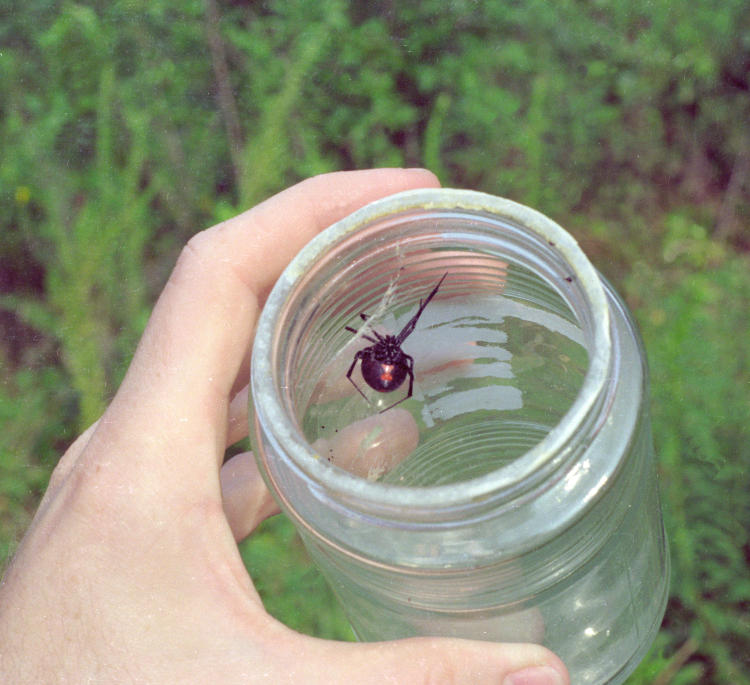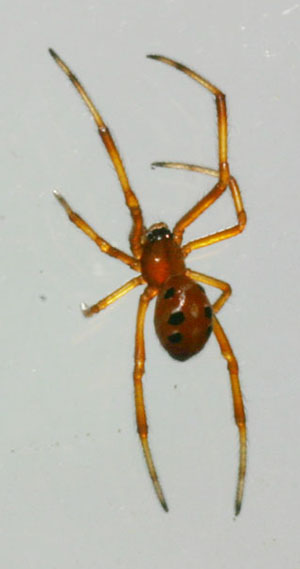
For our opening image this week, we have a female southern black widow (Latrodectus mactans,) the first that I’d seen. It dates from 1991, and was found in a rock cleft on a trail that I frequented – getting her out was a challenge, because widows are shy and prefer concealment, and of course I was endeavoring not to get bitten. Credit to the species, though, since they typically sit just like this in the web and thus display that red hourglass rather prominently.
This was taken with a Pentax K1000 and likely a 35-70mm lens. For a widow, she was massive, the size and hue of a Milk Dud, or as they call them in England, a Frommy-Lottle (okay, I lie – they probably just call them, ‘malted milk balls,’ like any decent person would.) At 10mm or so in abdominal girth, she was roughly twice the average size for the species, and probably about to produce an egg sac.
As a bit of trivia, my roommate at the time was allergic to insect venom, and a bite from a widow could easily have proven fatal even though it isn’t that dangerous to most people, so bringing the spider home was not the most circumspect thing I’ve done, but I made sure the lid of this jar was firmly tightened while in the apartment, at least. And I released her the next day after this photo (the spider, not the roommate.)
Now we go to 2013.

From time to time, I locate black widows in various locations – I won’t say they’re common, but they’re not rare around here. This time, I was determined to get some detail images and was working with another captive in a ‘studio’ environment – actually, out on the porch where she couldn’t get into the house, with an azalea sprig as the support, held in a clamp that was itself suspended in a pan of water to prevent escapes. And this was good, because she tried several times.
What I wanted to photograph was primarily the chelicerae (fangs,) but the eye detail was a secondary target. I achieved the second above, ever so slightly, because the two anterior median eyes are the bright spots reflecting from the top of the head. I did a little better just a couple minutes later.

All eight eyes are visible here, if you know what you’re looking at – a row of four in front, with two on a little hump in the center, and a row of four across the top seen edge-on. But the chelicerae remain hidden, and as of this post, I’ve still only gotten glimpses of them. This is largely because widows don’t hold still out in the open and won’t pose willingly, with an additional factor that the chelicerae are freaking tiny; this specimen is smaller than the first, abdomen probably 6-7mm in width, so the visible face here doesn’t top 3mm. This was taken with the Canon Digital Rebel/300D with the reversed Sigma 28-105, with the Sunpak FP38 flash and custom softbox for lighting (whole rig pictured here,) which made it possible to see this kind of detail without too much contrast or sharp specular highlights.
But while I’m here,

Taken in 2009, this is what a male black widow looks like, though I didn’t know it at the time – significantly smaller than the female, which is typical for spiders. And I don’t even know now if this is a southern or northern variant – the females have distinctive markings, but not the males to my knowledge. This was photographed on the edge of my main door, and possibly the dad of all the little bebby widows that hatched from the edge of my sliding door a little later on.
 The photo at right is the oldest from my blog folder, sized for a post it never made it into years ago; I can finally clear it out (into the ‘Uploaded’ folder now, so not really saving any harddrive space with a lateral move.) This is what a newborn black widow looks like, though again, not sure if northern or southern. This was one of the last stragglers that I discovered having hatched from the sliding door, thankfully outside the apartment, though where all the rest (dozens, if not hundreds) got to I couldn’t say. But yeah, they go through a radical color change into adulthood, and the juveniles have some funky coloration (that’s a juvenile female in that post, not a male – my knowledge evolves too.)
The photo at right is the oldest from my blog folder, sized for a post it never made it into years ago; I can finally clear it out (into the ‘Uploaded’ folder now, so not really saving any harddrive space with a lateral move.) This is what a newborn black widow looks like, though again, not sure if northern or southern. This was one of the last stragglers that I discovered having hatched from the sliding door, thankfully outside the apartment, though where all the rest (dozens, if not hundreds) got to I couldn’t say. But yeah, they go through a radical color change into adulthood, and the juveniles have some funky coloration (that’s a juvenile female in that post, not a male – my knowledge evolves too.)
You can probably imagine how small this is, but maximum 3mm in leg spread – it was hard to distinguish it from all the molted exoskeletons of the newborns that were left behind in the web. The mother was eventually, with some effort, evicted from her home in the track of the sliding door; I’m tolerant of a lot of wildlife incursions, but something venomous living where it could be encountered far too casually just wasn’t going to fly.




















































